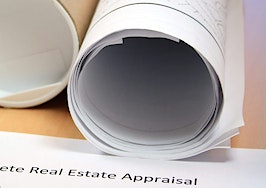Marty Haldane had a good job appraising homes for his family’s business, but when the recession hit he started tinkering with technology.
“How do we help appraisers make more money and be more efficient?” Haldane recalled wondering.

Marty Haldane
Gradually, Haldane and a friend built a software application they hoped would streamline the process. That software led Haldane to form a company — which he described as “almost a hobby” at the time — in 2011. Then by 2013, that so-called “hobby” had raised $1.1 million in funding.
Today, the company Haldane founded is called Anow. He said it processes more than 50,000 appraisals across the U.S., Canada and other countries each month, but the goal isn’t just volume. Instead, Haldane said, Anow is working to significantly streamline the appraisal process so that it’s both faster and more transparent than what most homebuyers currently experience.
Anow’s bread and butter is a software platform that appraisers can use to manage their workflow. The software tracks the progress of the appraisal, and includes other features including a calendar, invoicing tools, maps and analytics. Users can access the software via a mobile app, which the company says lets appraisers “stay in sync” no matter where they are.
“It’s really making the process streamlined for the appraiser,” Haldane added.

A screenshot shows how Anow’s software tracks appraisers while en route to homes. Credit: Anow
The platform also sends updates to other people involved in a real estate transaction — lenders, agents, buyers, etc. — which Haldane touted as a major selling point compared to the traditionally opaque, in-the-background process of a normal appraisal.
“We’ve got an Uber-like experience,” he said.
But unlike so many other companies touted as the “Uber” of their respective industries, Anow makes the comparison literal; people using the platform can actually see appraisers on a map en route to homes, much as the ride-hailing app makes drivers visible to passengers.
Agents and their clients do not need an app to receive updates from their appraisers. Instead, Anow’s platform emails them a link that can be viewed on the web. Haldane said the system is compatible with both computers and mobile devices.

An image showing one of Anow’s statues updates. Credit: Anow
Asked how many appraisers currently use Anow’s platform, Haldane replied “thousands.” He said the product currently has the greatest market penetration in the U.S., but is also used in several other countries including Canada, where Anow is based.
So far, Anow has primarily worked with appraisers themselves. The company charges individuals $29 per month. Businesses with 20 or more appraisers pay $499 per month.
More recently, Anow has also begun working with lenders and appraisal management companies, or AMCs. (AMCs are third party companies that typically work with high volume lenders to run their appraisals.) Lenders and AMCs using the platform have the option to log on and see a panel of available appraisers. They also get access to analytics and communication tools.
Haldane said pricing for lenders varies depending on the services they want, but typically costs $15 per transaction.
Anow believes that its platform offers a number of advantages over traditional appraisals. Questioned about those advantages, Haldane recalled buying his own home and said the ordeal dragged on after he had to get a conditional extension when the appraisal wasn’t finished quickly enough. Worse still, Haldane was in the dark during the entire process.
“We were just like, ‘come on we have no idea what’s happening,'” he recalled.
Haldane said that his experience is relatively common and that in many places “it takes 2 weeks to get an appraisal done and that’s crazy.” The process is bogged down by logistical issues such as unlocking a house or coordinating with various parties — issues Anow aims to solve by facilitating communication and providing status updates.
“I think people expect it these days,” Haldane added. “And we’re not just talking about a few hours of time savings. It’s days. It’s significant stuff.”
Though Anow’s speed varies by city, Haldane said that in Chicago appraisals using the company’s software are typically done within two to three days. In Houston, it’s a mere 24 hours.
Haldane said Anow has in recent years “just grown and grown and grown,” and the company expects to see future expansion as well.
But that may come as a surprise to some close observers of the industry who have been watching the rise of automatic valuation models. Also known as AVMs, the models use computers to arrive at an estimate of a home’s value. Zillow’s Zestimate and Redfin’s Estimate are both well-known examples of this technology, but other companies have been rolling out their own versions as well.
And while many AVMs are currently consumer-facing tools, there has long been speculation that they could eventually replace actual human appraisers.
Haldane, however, doesn’t think that’s going to happen. For one thing, he said that AVMs currently rely on data produced by conventional, human appraisals. And for another, eliminating people from the process entirely would mean “dealing with a lot of risk” for banks and lenders.
“I’m not anti-AVM at all,” Haldane said. “I think there’s certainly a place for them and it works. But it’s very difficult for them to be accurate.”
Haldane does believe the appraisal industry is changing, and expects major shifts soon. But, he argued, Anow’s technology solves some of the most painful inefficiencies in the appraisal process.
“The first step is really for appraisers to adopt modern tools,” he added. “And what we’re doing is basically making appraisers hyper efficient.”













